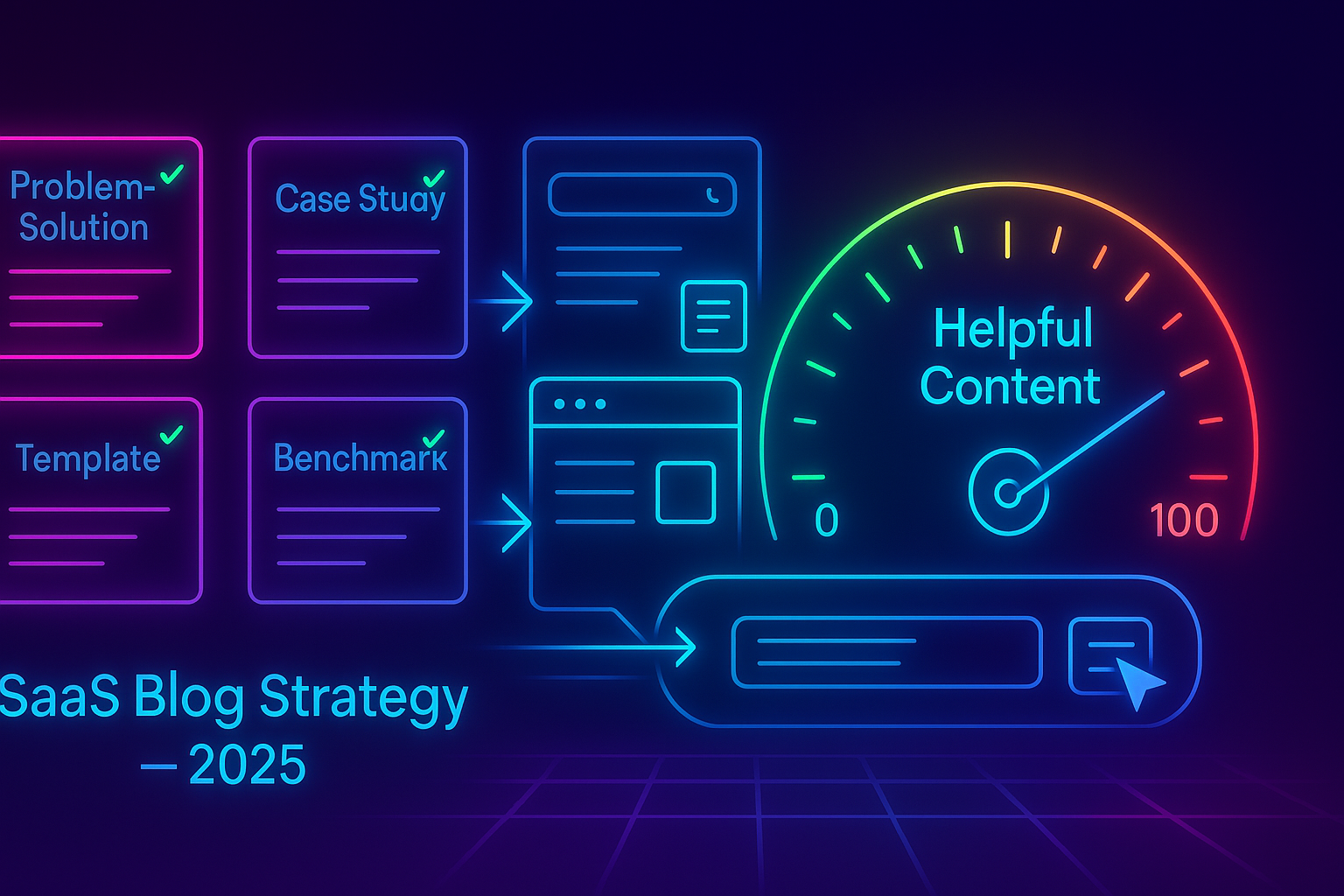Yes—SaaS blogs still work in 2025 when they prioritize helpful content: problem-first topics, original proof, clearer UX, and fast pages. Use this explainer, templates, and a rapid QA loop with SEO Horizan tools.
Is SaaS blog strategy still relevant with Helpful Content guidelines? (2025 explainer)
Short answer: yes—but only if your blog consistently solves real jobs, shows proof, and ships fast pages. In 2025, winning SaaS blogs look less like newsfeeds and more like help systems: problem-first, evidence-backed, and interlinked. Use this explainer to recalibrate your strategy and verify quality quickly with SEO Horizan.
What “helpful” means for SaaS blogs in 2025
- Job-to-be-done alignment: Posts map to pains, not keywords alone.
- Originality: Screenshots, benchmarks, or data summaries—something unique.
- Clear outcomes: A 40–55 word snippet paragraph that answers the core question.
- Operational UX: Scannable headings, internal links to product/guide pages, and zero redirect hops.
- Speed & stability: Lean images, compressed assets, and stable layout (LCP/INP/CLS in budget).
SaaS blog strategy that still works (model)
Pillars (evergreen)
├── Problem–Solution Guides (playbooks)
├── Templates & Calculators (downloadables)
├── Benchmarks & Data (original insights)
└── Case Studies (before/after, stack, ROI)
Supporting Posts
├── Quick wins & checklists
└── Opinionated takes (experience-led, not hot takes)
Editorial rules (keep or cut)
- Keep: Problem–solution posts with reproducible steps and assets.
- Keep: Case studies that show constraints, stack, and numbers.
- Keep: Templates, CSVs, and calculators that convert skimmers to doers.
- Cut or refit: Generic “top 10 tools” lists with no POV, thin AI rewrites, or posts without a testable outcome.
Helpful Content alignment checklist (15–30 min per post)
- Promise & CTR: Preview title/description in Google Search Preview; tighten to match intent.
- Meta & OG parity: Validate with Meta Tags Checker and OpenGraph Checker.
- Snippet paragraph: Ensure a 40–55 word answer near the top (confirm visibility via Website Text Extractor).
- Proof present: Add screenshots, a mini table, or a downloadable. Cite sources where needed.
- Link hygiene: Verify final 200s with URL Redirect Checker; confirm headers in HTTP Headers Lookup.
- Speed sanity: Keep TTFB < 600 ms and page < 2 MB using TTFB Checker and Website Page Size Checker.
Post templates (copy, then adapt)
Problem–Solution playbook
<article>
<h1>[Problem] in [Tool/Workflow]: the practical fix (2025)</h1>
<p class="snippet">[40–55 words: define the problem, state the outcome, name the steps/tools used].</p>
<h2>Symptoms & impact</h2> <ul><li>[Symptom 1]</li><li>[Symptom 2]</li></ul>
<h2>Steps</h2> <ol><li>[Step 1]</li><li>[Step 2]</li></ol>
<aside class="assets"><a href="/downloads/[template].csv" download>Download the template</a></aside>
<aside class="next">See also: <a href="/plan">Plans</a> • <a href="/blog">Related guides</a></aside>
</article>
Benchmark / Data summary
<article>
<h1>[Metric] benchmarks for [Audience] (2025)</h1>
<p class="snippet">[40–55 words: scope, sample size if applicable, key deltas users care about].</p>
<table><thead><tr><th>Segment</th><th>Median</th><th>Top quartile</th></tr></thead>
<tbody><tr><td>[Segment A]</td><td>—</td><td>—</td></tr></tbody></table>
<p>Methodology & caveats: [short paragraph].</p>
<aside class="next"><a href="/blog">Deep dives</a> • <a href="/plan">Plans</a></aside>
</article>
Cluster & interlinking (avoid cannibalization)
- One pillar hub per problem domain (e.g., “Lead quality”), listing sibling posts with blurbs.
- Each spoke links to the hub and 2–3 siblings with descriptive anchors.
- List hubs/spokes in your Sitemap.
Lightweight schema (only if visible content matches)
ArticleorBlogPostingfor most posts.FAQPageonly if you display Q&A blocks on the page.
{
"@context":"https://schema.org",
"@type":"BlogPosting",
"headline":"[Title]",
"description":"[Snippet paragraph]",
"mainEntityOfPage":"https://example.com/blog/[slug]"
}
Prioritization (do now → do next)
Item, Impact, Effort, Priority
Add snippet paragraphs to top 20 posts, High, Low, Do Now
Replace stock images with annotated screenshots, High, Low, Do Now
Publish 1 template or calculator per pillar, High, Medium, Do Now
Fix internal hops; update anchors to final URLs, Medium, Low, Do Now
Tune meta/OG on top landing posts, Medium, Low, Next
Compress heavy media; keep < 2 MB, Medium, Low, Next
Publishing checklist (don’t skip)
- ✅ Title/description preview clean (Google Search Preview); meta/OG validated (Meta Tags, OpenGraph).
- ✅ Snippet paragraph (40–55 words) appears near the top (confirmed via Website Text Extractor).
- ✅ Internal links go to final 200s (URL Redirect Checker); headers sane (HTTP Headers Lookup).
- ✅ Fast page: TTFB < 600 ms; payload < 2 MB (TTFB, Website Page Size Checker).
Where to link internally
- From pillar hubs to spokes and from spokes back to hubs.
- From posts to Plans, product/feature pages, and relevant Blog deep dives.
SEO Horizan Toolbox (bookmark these)
- Google Search Preview • Meta Tags Checker • OpenGraph Checker
- Website Text Extractor • URL Redirect Checker • HTTP Headers Lookup
- Website Page Size Checker • TTFB Checker • Image Alt Tags Checker
FAQs
Do SaaS blogs still drive pipeline in 2025?
Yes—when posts solve specific jobs, include proof/assets, and are interlinked to product pages with clear next steps.
How long should posts be?
Length is not the lever; usefulness is. Ship the snippet paragraph, steps, proof, and a downloadable. Add depth only where it helps.
What’s the fastest win if traffic is flat?
Add snippet paragraphs to top posts, fix meta/OG, and replace generic images with annotated screenshots. Interlink to high-intent pages.
Should every post use schema?
Keep it lean and accurate—BlogPosting for articles, FAQPage only with visible Q&A. No over-markup.
Wrap-up
SaaS blog strategy is alive—and stricter. Build around real jobs, ship proof and tools, keep pages fast, and link to outcomes. Use the templates and QA loop above to align with “helpful content” expectations. To operationalize this across your calendar, create an account or compare Plans.
